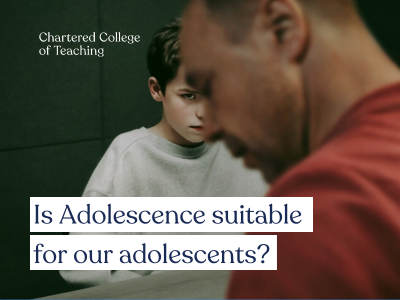The entertainment series Adolescence became an overnight success, quickly sparking conversations beyond the screen. Many educators and school leaders wondered whether the show could serve as a tool to address issues such as toxic masculinity and misogyny amongst young people. The pressure to incorporate Adolescence into classrooms grew, prompting a broader discussion on whether fiction should play a role in shaping student understanding of complex social issues.
Recently, we hosted a panel discussion to explore this very question. While Adolescence is undeniably compelling as a drama, the panel agreed that it is not suitable for educational use in schools.
Below are some key reasons why.
The complexity of the issues
The themes within Adolescence – bullying, gender identity and social media – are intricate and layered. The show, however, presents a simplified version of these issues that could lead to misunderstandings rather than clarity. To effectively teach young people about these topics, educators need well-researched, nuanced resources rather than a scripted drama designed for an adult audience.
A narrow perspective
The narrative of Adolescence focuses largely on the perpetrator, leaving out a broader view of the victims, bystanders and systemic influences. This limited storytelling approach may hinder students from fully grasping the social context surrounding these issues.
Risk of reinforcing stereotypes
One of the panel’s greatest concerns was the potential for misrepresentation. Boyhood is not monolithic; young men develop through varied experiences shaped by race, ethnicity, socioeconomic status and personal growth. The show’s portrayal may lead to oversimplification, painting all young men with the same brush.
Practical barriers and lack of pedagogical support
Watching the whole series would require four to six hours of classroom time, a logistical challenge in most secondary schools. Moreover, showing the programme alone, without guided discussion, would not guarantee that students interpret its messages or take any learning from the show. Meaningful learning requires thoughtful dialogue, expert facilitation and appropriate educational frameworks.
Fiction vs. education
Most importantly, Adolescence is entertainment; it was never designed as a teaching tool. No research supports its effectiveness in educating young people about relationships or social behaviour. While adults may see connections between the show and real-world issues, it does not mean students will do the same.
Conclusion
The discussion made one thing clear; relying on a drama series as an educational tool is insufficient. Teachers need timely training, expert insights and research-based strategies to support young people in navigating issues like toxic masculinity and misogyny. Instead of reactive solutions, schools must be supported to invest in resources that foster informed, proactive engagement with young people.
The urge to use Adolescence in schools highlights how deeply society reacts to media portrayals of gender and relationships. While the show may prompt valuable conversations amongst adults, it should not replace structured learning experiences designed specifically for young people.





